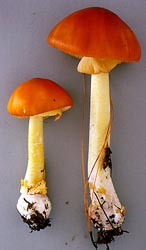|
[ Section Validae page. ]
[ Amanita Studies home. ]
[ Keys & Checklist/Picturebooks ] "Tarnished Yellow Dust Amanita" =Amanita flavoconia var. sinapicolor Tulloss, Ovrebo & Halling
Technical description (t.b.d.) BRIEF DESCRIPTION: The cap of Amanita flavoconia var. inquinata is 25 - 60 mm wide, orange-brown to fulvous when young then becoming paler with age (orange-yellow to yellow-orange to tan to orangy brown), darkest in the center with color at times sometimes appearing to be in innate radial fibrils, cap becoming dull yellow to mustard yellow after exposure to direct sunlight and/or desiccation in situ at high altitude, hemispheric to rounded conic to bell-shaped at first, eventually convex to plane, subviscid when moist, nonappendiculate, with a nonstriate margin at first, sometimes becoming slightly striate in age. The volva is absent or present as small, easily lost, yellow patches, submembranous, with a minutely warty surface, paler and brown slightly with age and drying. The flesh is white, yellowish-orange to concolorous with the cap just under the cap skin, and 2 - 4 mm thick above the stem. The gills are free to rather distant from the stem, close, 6 mm broad, white with orangish yellow to yellowish edge that can be absent at maturity. The short gills are of diverse lengths, and at least the shorter ones are truncate. The stem is 60 - 150 × 4 - 15 mm [Note: length includes bulb], white or pallid in part, but usually with yellow to orange regions above and/or below the ring, narrowing slightly upwards, flaring at the top of the stem, often shiny to silky. The bulb is starkly white, subglobose, slightly flattened longitudinally, sometimes faintly marginate or subabrupt. The ring is placed in the upper part of the stem or toward the middle, thin, membranous, persistent, collapsing on the stem, yellow to yellowish tan or yellowish brown below, browning with age, striate above, smooth below, eventually collapsing on the stem. The volva is present as yellow patches like those on the cap, easily lost in collecting, or forming a thin yellow rim around the top of the bulb. The flesh is white, solid at first, becoming hollow. The spores measure (5.2-) 6.8 - 9.0 (-11.5) × (4.5-) 5.8 - 7.5 (-9.5) µm and subglobose to broadly ellipsoid to ellipsoid, infrequently globose, rarely elongate, and amyloid. Clamps are absent at bases of basidia. The species is originally described from an oak (Quercus humboldtii) forest in Colombia in an elevation of 1900 - 2500 or more meters in loamy soil. In Costa Rica, it occurs 1675 - 3000 meters elevation in forests including oak (for example, Q. copeyensis, Q. costaricensis, Q. oocarpa, and Q. seemannii). In central Mexico, it is also known at high elevation in mixed forests of Fir (Abies religiosa), Arbutus alapinsus, Pine (Pinus patula), and oak (Quercus spp.). The present taxon is, so far as is known, geographically separated from the northern Amanita flavoconia G. F. Atk. var. flavoconia by the deserts of northern Mexico. While some Central American amanitas do appear in southeastern Arizona along with their Madrean host trees, the present taxon has not yet been found there. It is distinguished from the type variety of A. flavoconia by its pigmentation and its distinctly more rounded spores. A. flavoconia var. sinapicolor was originally described from Costa Rica. In 1995, RET and Dr. R. E. Halling were at 3000 meters elevation in Costa Rica and found specimens exactly matching the original description of var. sinapicolor with mustard yellow to dull yellow caps; however, these mushrooms were growing in part of a ring which contained var. inquinata in the shade and var. sinapicolor in the bright sun. The experience convinced them that the two taxa were in fact one. From experience in Costa Rica and Mexico, the present taxon appears as commonly in its season as does its northern sister variety in the North American summer. For comparison, see the list of species provided for Amanita flavoconia G. F. Atk. var. flavoconia. -- R. E. Tulloss and L. Possiel Photos: R. E. Tulloss (left, Mexico; right, Costa Rica).
[ Section Validae page. ]
[ Amanita Studies home. ]
[ Keys & Checklist/Picturebooks ] Last changed 21 January 2009. |

